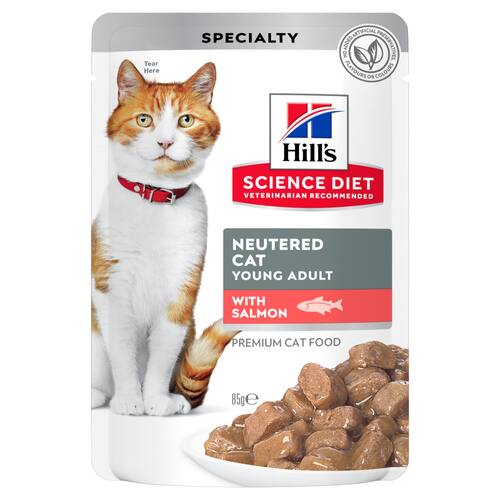
-
Find the right food for your petTake this quiz to see which food may be the best for your furry friend.Find the right food for your petTake this quiz to see which food may be the best for your furry friend.Health CategoryFeatured products
 Adult Small Bites Chicken & Barley Recipe Dog Food
Adult Small Bites Chicken & Barley Recipe Dog FoodSupports lean muscle for dogs who prefer smaller kibble
Shop Now Adult Oral Care Small & Mini Chicken, Rice & Barley Recipe Dog Food
Adult Oral Care Small & Mini Chicken, Rice & Barley Recipe Dog FoodClinically proven kibble technology to reduce plaque & tartar build-up, specially designed for small & mini dogs
Shop Now Adult 7+ Small Bites Chicken Meal, Barley & Rice Recipe Dog Food
Adult 7+ Small Bites Chicken Meal, Barley & Rice Recipe Dog FoodSupports energy level and beautiful coat in mature dogs who prefer smaller kibble
Shop NowFeatured products Adult Tender Chicken Dinner Cat Food
Adult Tender Chicken Dinner Cat FoodPrecisely balanced nutrition to support immunity, healthy digestion and lean muscles in cats
Shop Now Neutered Cat Young Adult with Salmon Cat Food
Neutered Cat Young Adult with Salmon Cat FoodPrecisely balanced nutrition with the delicious taste of salmon to meet the needs of neutered cats
Shop Now Kitten Tender Chicken Dinner
Kitten Tender Chicken DinnerWith delicious chunks in a decadent gravy
Shop Now -
DogCat
- Cat Tips & Articles
-
Health Category
- Weight
- Skin & Food Sensitivities
- Urinary
- Digestive
- Kidney
- Dental
- Serious Illness
-
Life Stage
- Kitten Nutrition
- Adult Nutrition
Featured articles Water
WaterWater is the most important nutrient of all and essential for life. Animals can lose almost all their fat and half their protein and still survive, but if they lose 15% of their water, it will mean death.
Read MoreHill's Australian Bushfire EffortsRead More Pet Food Storage Tips
Pet Food Storage TipsWhere you store your cat and dog food can make a big difference in the quality and freshness once it is opened. Here are some common questions and recommendations for optimal storage for all of Hill’s dry and canned cat and dog food.
Read More -


Dogs communicate through barking – it's as natural to them as speaking is to us. But when your furry friend's vocalisations become excessive, it can strain the harmony of your household and potentially disturb your neighbours. If you're wondering how to stop dogs from barking excessively, you're not alone. Many Australian pet parents face this challenge daily.
The good news is that with patience, understanding, and the right approach, you can help your dog develop better communication habits. This comprehensive guide will help you understand why dogs bark, identify your pet's specific triggers, and implement effective training strategies. Rather than simply silencing your dog, we'll focus on addressing the root causes of excessive barking and building a stronger bond with your four-legged companion.
Why Dogs Bark: Understanding the Different Types
Before you can effectively address excessive barking, it's crucial to understand why your dog is vocalising. Dogs bark for various reasons, and each type of barking requires a different approach. Here are the main categories:
Territorial or Protective Barking When someone or something enters what your dog perceives as their territory, they may bark to warn off the intruder. This type of barking often gets louder and more intense as the perceived threat approaches. Your dog's body language will typically be alert and rigid, with their tail held high.
Alarm or Fear Barking Dogs bark when startled or frightened by sudden noises or movements. This barking is usually sharp and short, accompanied by a startled body posture. Your dog might bark at thunderstorms, fireworks, or unexpected visitors.
Attention-Seeking Barking Some dogs learn that barking gets them what they want – whether it's food, playtime, or simply your attention. This type of barking is often persistent and directed specifically at you, with pauses to see if you'll respond.
Greeting or Play Barking Happy, excited barking occurs when dogs greet people or other animals, or during play. This barking is typically accompanied by a wagging tail, relaxed body posture, and playful movements.
Compulsive Barking Some dogs develop repetitive barking habits, often while performing repetitive movements like running along a fence line. This behaviour can indicate underlying stress or inadequate mental stimulation.
Socially Facilitated Barking Dogs are social creatures and often bark simply because other dogs are barking. This is particularly common in multi-dog households or neighbourhoods with many pets.
Frustration-Induced Barking: When dogs can't reach something they want, such as a possum in a tree or a toy under the sofa, they may bark out of frustration. This barking is often accompanied by whining or other signs of distress.
Separation Anxiety Barking Dogs with separation anxiety often bark excessively when left alone. This barking is usually accompanied by other stress behaviours like pacing, destructiveness, or inappropriate elimination.

Identifying Your Dog's Barking Triggers
Playing detective is essential to solving your dog's barking puzzle. Every dog is unique, and understanding your pet's specific triggers will help you develop an effective management plan.
Start by creating a barking diary. Note down:
- Time of day the barking occurs
- Duration of barking episodes
- What happens immediately before barking starts
- Your dog's body language
- How the barking episode ends
Look for patterns in your observations. Does your dog bark more in the morning when people walk past your house? Do they vocalise when a delivery arrives at the door? Understanding these patterns helps you anticipate and prevent barking episodes.
Pay attention to your dog's body language during barking episodes. A stiff, forward-leaning posture suggests territorial barking, while cowering or backing away indicates fear. A play bow or bouncing movements signal excitement, while pacing or restlessness might indicate anxiety.
Environmental factors play a significant role too. Consider:
- Visual stimuli (people, animals, vehicles passing by)
- Auditory triggers (doorbells, car horns, other dogs)
- Changes in routine or household dynamics
- Weather conditions (storms, wind)


Tasty Tips
Prevention Strategies: Creating an Environment for Success
Preventing excessive barking is often easier than stopping it once it's become a habit. Here are key strategies to set your dog up for success:
Exercise and Mental Stimulation A tired dog is generally a quieter dog. Ensure your pet gets adequate physical exercise appropriate for their age, breed, and health status. Mental stimulation through puzzle toys, training sessions, and interactive games is equally important. Dogs need both physical and mental outlets for their energy.
Consider incorporating activities like:
- Daily walks or runs
- Fetch or frisbee sessions
- Swimming (for water-loving breeds)
- Agility training
- Scent work games
- Food puzzle toys
Environmental Management Modify your dog's environment to reduce barking triggers:
- Close curtains or blinds to block visual stimuli
- Use white noise or calming music to mask outside sounds
- Create a designated quiet space where your dog feels secure
- Rearrange furniture to prevent window access if needed
Establishing Routine Dogs thrive on predictability. Establish consistent times for:
- Meals
- Walks and exercise
- Play sessions
- Training time
- Quiet time/rest
A predictable routine helps reduce anxiety-driven barking and gives your dog structure throughout the day. When choosing food for your routine feeding times, consider Hill's Science Diet food, with a range of options for your dog's age, size and a variety of needs.
Addressing Anxiety If anxiety triggers your dog's barking, work on building their confidence:
- Gradual desensitisation to triggers
- Positive associations with previously scary stimuli
- Calming techniques like massage or touch
- Safe spaces where your dog can retreat
Appropriate Socialisation Well-socialised dogs are generally less reactive and bark less at normal stimuli. Continue socialisation throughout your dog's life by:
- Regular positive interactions with people and other dogs
- Exposure to various environments and situations
- Rewarding calm behaviour around triggers

Training Techniques: Positive Reinforcement Methods
Effective training focuses on teaching your dog what you want them to do rather than simply punishing unwanted behaviour. Here are proven techniques to reduce excessive barking:
Teaching the "Quiet" Command
- Wait for your dog to bark naturally
- Say "quiet" in a calm, firm voice
- When they stop barking (even briefly), immediately praise and treat
- Gradually increase the duration of quiet before rewarding
- Practice in various situations with different triggers
Desensitisation and Counter-Conditioning This technique helps change your dog's emotional response to triggers:
- Identify the trigger at a distance where your dog notices but doesn't bark
- Reward calm behaviour at this distance
- Gradually decrease the distance over multiple sessions
- Pair the trigger with positive experiences (treats, play)
- Move at your dog's pace – rushing can set back progress
Removing the Motivation Sometimes the simplest solution is removing what motivates the barking:
- If your dog barks at passersby, block their view
- If they bark for attention, ensure they only receive it when quiet
- If they bark for food, establish regular meal times
Ignoring Attention-Seeking Barking This requires patience but can be highly effective:
- Don't look at, touch, or speak to your barking dog
- Turn away or leave the room if necessary
- Return or give attention only when they're quiet
- Be consistent – inconsistency reinforces the barking
Teaching Alternative Behaviours Give your dog something else to do instead of barking:
- Teach them to fetch a toy when excited
- Train a "go to your bed" command for when visitors arrive
- Use "look at me" to redirect attention from triggers
Common Training Mistakes to Avoid
- Yelling (sounds like barking to your dog)
- Inconsistent responses
- Rewarding barking accidentally
- Punishment-based methods
- Giving up too quickly
When to Seek Professional Help
Sometimes excessive barking requires professional intervention. Consider consulting a qualified animal behaviourist or your veterinarian if:
- Barking suddenly increases or changes pattern
- Your dog shows signs of severe anxiety or fear
- Training techniques aren't showing improvement after consistent application
- Barking is accompanied by aggression
- You suspect an underlying medical issue
Your veterinarian can rule out medical causes such as:
- Pain or discomfort
- Cognitive dysfunction in older dogs
- Hearing loss
- Hormonal imbalances
For dogs experiencing discomfort that might contribute to excessive barking, your vet may recommend a Hill's Prescription Diet food if your dog has a health condition that is causing discomfort and triggering barking, which can help address underlying concerns.
Working with a certified professional dog trainer or veterinary behaviourist provides:
- Customised behaviour modification plans
- Hands-on training demonstrations
- Ongoing support and plan adjustments
- Expertise in complex cases
Tools and Products: Helpful Aids (Not Quick Fixes)
While training and environmental management are the foundations of addressing excessive barking, certain tools can support your efforts:
Helpful Tools
- White noise machines or calming music
- Interactive puzzle toys for mental stimulation
- Comfortable, secure crates for anxious dogs
- Window films to reduce visual triggers
- Exercise equipment (balls, frisbees, agility equipment)
Calming Aids (Always consult your vet first)
- Pheromone diffusers
- Anxiety wraps or thundershirts
- Natural calming supplements
- Prescribed medications for severe cases
What to Avoid
- Shock collars (can increase anxiety and aggression)
- Citronella spray collars (often ineffective and stressful)
- Ultrasonic devices (may cause stress without addressing the cause)
- Any punishment-based tools
Remember, these tools should complement training, not replace it. No product alone will solve excessive barking without addressing the underlying cause.
Breed-Specific Considerations
Understanding your dog's breed characteristics helps set realistic expectations and tailor your approach:
Breeds Prone to Barking Some breeds were developed to bark as part of their job:
- Terriers (bred to alert to prey)
- Hounds (bark when tracking)
- Herding breeds (vocal communication with livestock)
- Small companion breeds (bred as watchdogs)
Working with Natural Instincts Rather than fighting breed tendencies:
- Channel vocal breeds into appropriate activities
- Provide adequate mental stimulation for working breeds
- Understand and respect your dog's communication style
Set realistic goals based on breed characteristics
Individual Variation Remember that while breed tendencies exist, every dog is an individual. Some typically quiet breeds may be vocal, while some traditionally barky breeds may be reserved.
Learning how to stop dogs from barking excessively requires patience, consistency, and understanding. By identifying why your dog barks and addressing the root cause rather than just the symptom, you'll build a stronger relationship with your pet while creating a more peaceful home environment.
Remember these key points:
- Understand the type and triggers of your dog's barking
- Prevent barking through exercise, routine, and environmental management
- Use positive reinforcement training methods
- Seek professional help when needed
- Be patient and celebrate small victories
Every dog can learn better communication habits with the right approach. Stay consistent with your training, maintain realistic expectations, and remember that reducing excessive barking is a journey, not a destination. With time and dedication, you and your dog will develop a deeper understanding of each other, strengthening the special bond you share.
Your dog's voice is important – the goal isn't to silence them completely but to help them communicate more appropriately. By following these guidelines and remaining committed to positive training methods, you'll help your furry friend become a more considerate canine citizen while maintaining their natural ability to alert and communicate when truly necessary.


One of our staff authors prepared this article for you
Related products

Clinically proven kibble technology to reduce plaque & tartar build-up, specially designed for small & mini dogs

Supports healthy joints, lean muscle, and beautiful coat for large breed dogs

Supports lean muscle for dogs who prefer smaller kibble

Supports energy level and beautiful coat in mature dogs who prefer smaller kibble
Related articles

Learn how today's wet dog food blends have gotten a face lift, and how you'll provide your dog the nutrition he needs in the form he loves.

Extra pounds can cause problems for your dog's overall health. Learn the signs that your dog might be overweight, and what you can do to manage its weight.

As small and toy breed dogs age, their nutritional needs change.

Selecting the right food for your puppy is a key to quality nutrition and a long, healthy life., Learn more about how to select the right puppy food.

Put your dog on a diet without them knowing
Our low calorie formula helps you control your dog's weight. It's packed with high-quality protein for building lean muscles, and made with purposeful ingredients for a flavorful, nutritious meal. Clinically proven antioxidants, Vitamin C+E, help promote a healthy immune system.
Put your dog on a diet without them knowing
Our low calorie formula helps you control your dog's weight. It's packed with high-quality protein for building lean muscles, and made with purposeful ingredients for a flavorful, nutritious meal. Clinically proven antioxidants, Vitamin C+E, help promote a healthy immune system.

